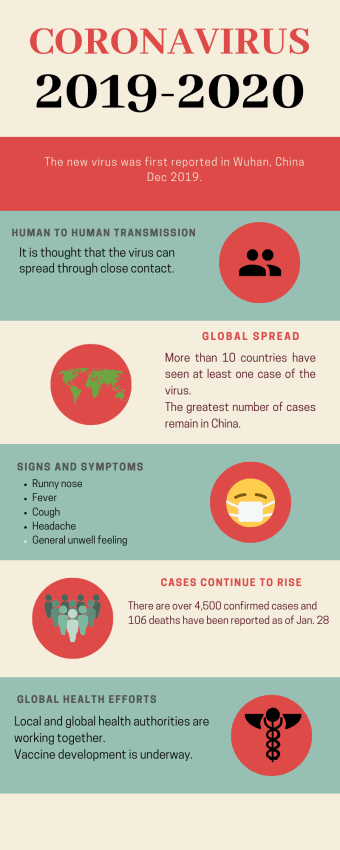In late December, reports began to circulate of a “mysterious pneumonia” originating in Wuhan, China, a city of 11 million. The 27 cases of a “SARS-like illness” were linked to a wet market and thought to be caused by a new coronavirus. By Jan. 28, the illness had spread with 4,500 confirmed infections and 106 deaths. Should we be worried?

With the events changing rapidly and an influx of unconfirmed videos, texts, and tweets filling social media, it’s hard not to feel a sense of panic and urgency. But let’s take a look at what we do know and define a few key things.
Words like “novel,” “coronavirus” and “pandemic” have been floating around, but it may be difficult to decipher the meaning of these terms if you are not familiar.
Novel simply means new and is often used to describe emerging or newly-discovered viruses. Novel viruses are always monitored with caution because we don’t know how our bodies will respond or the severity of the illness.
This latest outbreak has been confirmed as a novel coronavirus. It is thought to be zoonotic in origin, meaning that it “spilled over” from animals to humans.
Coronavirus is simply a name given to a group of viruses that we come in contact with frequently. These viruses are one of the causes of the common cold, but they are also the source of severe diseases like SARS and MERS.
So is this novel coronavirus a possible pandemic?
Pandemic is a term used to describe an outbreak of illness that moves from an isolated pocket to a large global spread. At time of publication, the World Health Organization has yet to declare a global health emergency and hesitates to call the Wuhan outbreak a pandemic.
This is in spite of the fact that it has spread throughout China, triggering an unprecedented travel ban — locking down 17 cities.
With cases reported in 19 countries as of Jan. 27, it is difficult to say if these restrictions will quell the spread of the illness or if the WHO will change its mind on an emergency declaration.
While the rapidly increasing numbers are worrisome, let’s put this into perspective. This new coronavirus appears to have a death rate of three per cent which seems to be holding steady even as the number of infections rises. SARS, the illness it is often compared to, had a death rate of 14 per cent.
The United States reported a 10.8 per cent death rate during the peak of the 2018 influenza season. The regular ol’ flu virus — that you don’t feel you need to vaccinate yourself against — is much more likely to kill you. So far anyway.
But how contagious or infectious is this virus? This is estimated by a number called an R₀ or ‘R naught’. While it seems like it’s burning through the population, the WHO has estimated that this virus has an R₀ of 2.5 — meaning that roughly two people will be infected by one person who is ill.
Measles, a disease that is making a roaring comeback due to a lax in vaccination rates, has an R₀ of 12 to 18. This makes it one of the most contagious viruses currently circulating.
It is alright to be concerned about emerging illnesses, especially when deaths are reported, but it’s best to keep everything in perspective. We need to be vigilant about illnesses like this, but panic often complicates an already complicated situation.
Currently, global health agencies and researchers are working to understand and manage the outbreak.
It is still too early to know exactly the direction that this illness may take, but staying informed with sources of reliable information is something we can all do.
Update on the novel coronavirus as of Feb. 2, 2020
There have been several significant updates about the coronavirus outbreak since publication of this article. As of Feb. 2, 2020, there have been reports of the virus in 28 countries, including four cases in Canada.
The first patient to be diagnosed in Toronto has been released from the hospital earlier this week.The third case from Canada involved a woman with mild symptoms who originally tested negative for the virus. A secondary test came back as weakly positive.
The majority of deaths have been reported in older male populations in China who had pre-existing health conditions.
Currently, there have been over 16,000 confirmed cases and 360 deaths. With that number expected to rise. Holding around a case fatality rate of 2.2 per cent, the virus has surpassed the total number of SARS infections seen during the 2003 outbreak. However, it should be emphasized that SARS was far more deadly with a nine per cent mortality rate.
The WHO updated their earlier recommendations, announcing a global health emergency on Jan. 30, 2020. The decision should not incite panic. It is the best way to coordinate a response to the virus’ spread and mobilize needed resources.
To further complicate the situation, an outbreak of the highly pathogenic H5N1 bird flu has been reported among poultry in Hunan province, near the center of the coronavirus outbreak. This strain of bird flu spreads rapidly through bird populations. China has killed 18,000 chickens so far in an attempt to control the outbreak.
Not only a financial burden to the country, bird flu also poses a serious human health risk. While the virus is not easily transmitted from birds to humans or from human to human, there still have been 860 cases since 2003. H5N1 is a very deadly virus, with a 52 to 60 per cent mortality rate witnessed in humans.
Monitoring and controlling this H5N1 outbreak among chickens is crucial to avoid both economic strain and further threats to human health.
—
Erin Matthews/ Opinions Editor
Graphic: Erin Matthews/ Opinions Editor